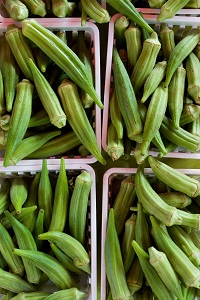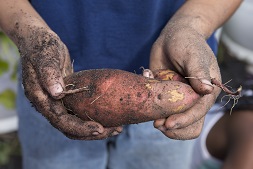As if we needed another reason to call Florida ‘Special’, what with our state hanging out into the water and located south of the rest of the nation. Here in Central Florida, we even seem to do our gardening backwards. We can grow edibles all year round, especially when the rest of the nation is tucked under a white blanket. Vegetable gardening in the summer months is very different here in the south.
Unlike other states, summer is the time we like to take it easy in the vegetable patch. The hot season is NOT the time to cram as many edibles into garden beds as possible. It is a time for doing the bare minimum to keep us out of the withering heat after 9:00 AM.

Our summer temperatures and humidity ranges will not easily support the usual tomatoes, peppers, squashes, and especially not the brassicas like broccoli, radish, and cauliflower. Those crops grow here in the fall through spring seasons. By May, those are being culled, the garden beds put to rest for the summer months under a cover crop or ‘solarization’ plastic. Although there are some heat tolerant vegetable varieties, even those may suffer under our brutal summer conditions.
Heat Tolerant, Low Maintenance Edibles

However, there are several heat tolerant, low maintenance edible crops which can be grown right now, in July and August. According to the University of Florida’s “Central Florida Gardening Calendar”, late May to early June is a great time to start sweet potatoes, okra and southern peas. Heat loving herbs like basil, rosemary, and Mexican tarragon will also thrive. July is the best time to include pumpkins like Calabaza. I am currently growing everything but the okra and the tarragon.
Crop Rotation in the Vegetable Garden
Be mindful of your crop rotation schedule when deciding what to grow in your garden beds. Think ahead to what vegetables will be planted in these beds next season. My summer vegetable gardening is being done outside my dedicated raised vegetable beds so this was not an issue this season. Those beds are under beneficial cover crops at the moment. For my blog article on cover cropping, click HERE.
The Pluses and Minuses of a Summer Garden
I started southern peas and basil from seed the first week of May. They were planted two weeks later into the garden beds. After some initial issues with aphids, the peas took off and started producing within a month of being planted.

The basil has been pinched and used throughout the summer in sauces, salads, and pesto.
Sweet potato slips and pumpkin vines were introduced several days later. After a few days of establishment watering, they were mostly left to survive on rainfall. Of the eight sweet potato slips I planted, only one little plant is still struggling along. The neighborhood rabbits are very fond of sweet potato leaves. The rabbits have moved on

to feast on the pea vines now that the sweet potato leaves are not so plentiful. I will leave the “deterring rabbits” topic for another blog.
I planted the pumpkin vines too early but they are finally perking up this week. I am looking forward to some nice roasted Seminole pumpkins or pumpkin soup in the fall. I must remember to save some of those seeds for next year’s crop as Seminole pumpkin seeds are a bit harder to find.
Here are some links to help you with your summer vegetable gardening, you can read during the hot part of the day, somewhat like northerners do during the winter. Enjoy and keep cool!
University of Florida Electronic Data Information Source publications:
“Central Florida Gardening Calendar”: https://edis.ifas.ufl.edu/ep450.
“South Florida Gardening Calendar“: https://edis.ifas.ufl.edu/ep452.
“Florida Vegetable Gardening Guide“: https://edis.ifas.ufl.edu/vh021.
“Calabaza- Curcurbita moschata Duch. ex Lam.1″: https://edis.ifas.ufl.edu/mv039
“Benefits of Cover Crops for Soil Health“: https://edis.ifas.ufl.edu/ag277.
“Introduction to Soil Solarization“: https://edis.ifas.ufl.edu/in856.
Sweet Potato Insect management publications: https://edis.ifas.ufl.edu/topic_sweet_potato_pest_insects
 0
0
